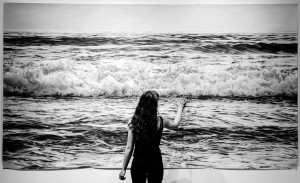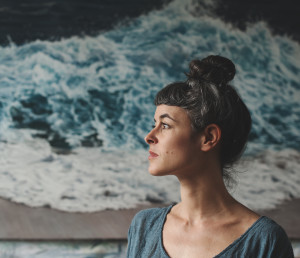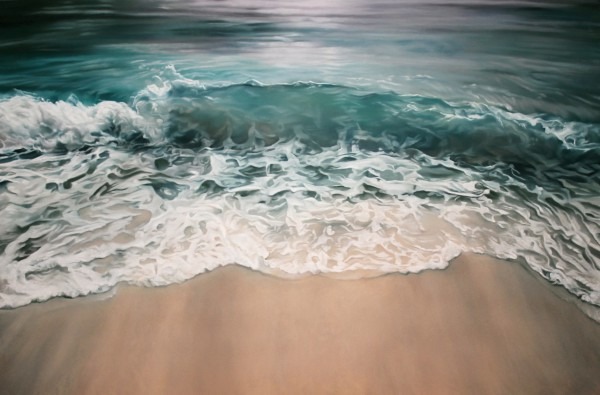I consider it my life’s mission to convey the urgency of climate change through my work. I have traveled north to the Arctic to capture the unfolding story of polar melt and south to the equator to document the subsequent rising seas. Recently, I visited the icy coasts of Greenland and the low-lying islands of the Maldives—two seemingly disparate but equally endangered parts of our planet.
My drawings explore transition, turbulence, and tranquility in the landscape, allowing viewers to connect emotionally with a place they may never have the chance to see. I choose to convey the beauty rather than the devastation. If you can experience the sublimity of these landscapes, perhaps you will be inspired to protect and preserve them.
Behavioral psychology tells us that we take action and make decisions based on emotion above all else. Studies have shown that art can impact our emotions more effectively than a frightening news report. Experts predict ice-free Arctic summers as early as 2020. Sea levels are likely to rise between two and seven feet by century’s end. I have dedicated my career to illuminating these projections through an accessible medium, one that moves us in a way that statistics may not. Artists play a critical role in communicating climate change, which is arguably the most important challenge we face as a global community.

My process begins with visiting the places at the forefront of climate change. I take thousands of photographs on site. Back in the studio, I use my memory of the experience and the photographs to create large-scale compositions, sometimes more than ten feet wide. I draw with soft pastel that is dry like charcoal but colors. I consider my work drawing; others call it painting. I cringe when I’m referred to as a “finger painter,” but I don’t use any tools and have always used my fingers and palms to manipulate the pigment on the paper.
I have been drawing ever since I could hold a crayon. I grew up with an artist mom, and we always had art supplies all over the house. My mother’s love of photography propelled her to the most remote regions of the earth. My family and I were fortunate enough to join and support her on these adventures. We rode camels in the Sahara Desert and went mushing near the North Pole.
In August 2012 I led my first expedition, taking a group of artists and scholars up the northwest coast of Greenland. Originally, my mother was supposed to lead the trip. We were in the early stages of planning when she fell victim to a brain tumor. Her dedication to the expedition never wavered during the six difficult months of her illness, and, before she passed away, I promised to carry out her final journey.
My mother’s affection for the Arctic echoed throughout my stay in Greenland, where I was awed by the power and the fragility of the landscape. The sheer size of the icebergs is humbling; the ice fields are alive with unexpected movement and sound and the sapphire colors of aged, compressed ice are staggering. Yet while the grandeur of the ice is evident, so is its vulnerability: from our boat, I could see the icebergs sweating under the unseasonably warm sun.
We were privileged to visit Inuit communities in Greenland that continue to face grave challenges. The locals spoke to me of vast areas of sea ice that are no longer freezing over as they once did. Without ice, their hunting and harvesting grounds are severely diminished, threatening their way of life and their very survival. The melting glaciers in Greenland are one of the major factors contributing to rising sea levels, which have already begun to drown some of the world’s lowest lying islands.
One year after my trip to Greenland, I flew to the Maldives, the lowest and flattest country in the world, comprising hundreds of islands in the Indian Ocean that are threatened by these rising sea levels. Two award-winning artists who participated in the Greenland expedition joined me: the painter Lisa Lebofsky; and the director, filmmaker, and actress Drew Denny. In collaboration with Ecocare, an environmental organization in the Maldives, the three of us offered a workshop and presentation at the Iskandar School in Malé, the nation’s capital. We met with middle-school students to share the concept of our project and what we had learned from speaking with scientists. We provided them with art materials and invited them to document their homeland as they have witnessed it transforming during their lives. Our hope is that the children, through their creativity, can both spread awareness of the urgency of climate change and inwardly process the ecological transformations surrounding them.

While there, I collected images and inspiration for a new body of work: drawings of waves lapping on the coast of a nation that could be entirely underwater within this century. Maldives No. 1, exhibited in Environmental Impact, is the first drawing in the series. It depicts the stormy afternoon on the day we arrived. The dark waves gather strength as the ominous foamy sea swallows the sandy beach—portending the dire things to come. The anger of the sea was palpable, the vulnerability of the tiny islands all the more so.
I scattered my mother’s ashes amid the melting ice in Greenland. Now she remains a part of the landscape she loved so much, even as it, too, passes and takes on a new form. The icebergs and the low-lying islands become a metaphor for notions of impermanence and the threat that climate change presents to our world. My drawings celebrate the beauty of what we stand to lose. I hope they can serve as records of sublime landscapes in flux, documenting the transition and inspiring our global community to take action before it’s too late.
The artworks by Zaria Forman published in this post are currently on national tour in the traveling museum exhibition, Environmental Impact.
 The inspiration for Zaria Forman’s artwork began in early childhood when she traveled with her family throughout several of the world’s most remote landscapes, which were the subject of her mother’s fine art photography.
The inspiration for Zaria Forman’s artwork began in early childhood when she traveled with her family throughout several of the world’s most remote landscapes, which were the subject of her mother’s fine art photography.
Zaria’s works have been in publications such as National Geographic Magazine, Huffington Post, and the Smithsonian Magazine. Zaria was featured on Good Day New York, Fox News, and interviewed by Lucy Yang on ABC7 Eyewitness News. In 2015, Zaria delivered a TED Talk at TEDTalksLive NYC, which will be featured March 30, 2016 on PBS.
Her drawings have been used in the set design for the Netflix TV series House of Cards. Zaria’s most recent achievements include participation in Banksy’s Dismaland, and a solo exhibition at Winston Wächter Fine Art in New York in September and October of 2015.
Born in South Natick, Massachusetts, Zaria currently works and resides in Brooklyn, New York. She studied at the Student Art Centers International in Florence, Italy and received a BS in Studio Arts at Skidmore College in New York
This post is part of the newly launched MAHB’s Arts Community space –an open space for MAHB members to share, discuss, and connect with artistic processes and products pushing for change. Please visit the MAHB Arts Community to share and reflect on how art can promote critical changes in behavior and systems. Please contact Erika with any questions or suggestions you have regarding the new space.
MAHB-UTS Blogs are a joint venture between the University of Technology Sydney and the Millennium Alliance for Humanity and the Biosphere. Questions should be directed to joan@mahbonline.org
MAHB Blog: https://mahb.stanford.edu/blog/the-beauty-of-what-we-stand-to-lose
The views and opinions expressed through the MAHB Website are those of the contributing authors and do not necessarily reflect an official position of the MAHB. The MAHB aims to share a range of perspectives and welcomes the discussions that they prompt.
